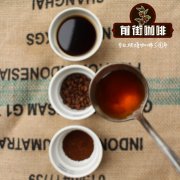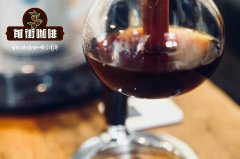Where do Sumatra coffee beans come from? What is the price of front street [Sumatra coffee beans]? How to cook

Professional coffee knowledge exchange more coffee bean information please follow the coffee workshop (Wechat official account cafe_style)
Where do Sumatra coffee beans come from? What is the price of front street [Sumatra coffee beans]? How to cook Sumatra coffee beans?
Qianjie, Indonesia Sumatra Aceh Tiger Mantenin imported G1 fresh deep-baked boutique coffee beans 79 yuan 227g
In the front street, Indonesia PWN gold Mantenin black coffee beans G1 washed imported single boutique fresh deep baking 89 yuan 227g
Qianjie Indonesia aged Mantenin Aged Mandheling G1 washing imported single boutique fresh baking 89 yuan 227g
Indonesia is a country composed of many islands, large and small, centered around the equator. Coffee production is the third in the world, most of which are Romsda varieties. Elaraby is also grown in Java, Sulawesi and Sumatra, especially Mantenin Coffee in Sumatra, which can be said to be the representative of Indonesian coffee, of which GRADE 1 is the best with the least defective beans. Sumatra manning coffee from the Indonesian island of Sumatra is the most famous, it has two famous names, Sumatra mantenin DP first class and collection Sumatra mantenin. Sumatra Mantenin DP has a long aftertaste, with a hillside fragrance, which is unique to the earthy taste of the primeval forest. In addition to the mellow taste of Indonesian coffee, there is also a bitter sweet taste, sometimes mixed with a touch of mildew, which is popular with people who like to drink concentrated roasted coffee. Sumatran Mantenin coffee is called "classic" because it is stored in the cellar for three years before export. But the collection coffee is not old coffee, but slightly pale coffee through special treatment, this kind of coffee is more full-bodied, the acidity will decrease, but the mellowness will increase, the finish will be longer, and will bring a strong spicy flavor, sometimes sour, sometimes walnut, sometimes chocolate. Before Blue Mountain Coffee was discovered, Manning was regarded as the best coffee.
Manning Coffee treatment:
After peeling off the peel in other Mandheling Mantenin producing areas, the sticky material is allowed to dry and adhere to the beans, as in Brazilian semi-washing treatment. Then use a machine to remove the sun-dried sticky and silver skin. Finally, it goes through the same two-stage drying, first in the middleman's warehouse and then in the exporter's warehouse in Medan's port of Medan.
The process of these treatments is described in such detail because it is not clear that the soil and atmosphere and the unusual treatment techniques and the extent to which the three stages of drying affect the formation of the characteristics of Lindong and Mantenin coffee. Only one thing is certain. These treatments occasionally produce excellent coffee and are extremely unstable. Only through the merciless selection in the Medan port exporter's warehouse can the deep texture and unique and low-key rich taste of Lintong Lindong and Mandheling Mantenin emerge from the interference of other smells. Sumatra manning manning is a fine coffee bean grown in the original Michael mountains of 750 murmur1500 above sea level.
In the 17th century, the Dutch first introduced Arabica saplings to Ceylon (present-day Sri Lanka) and Indonesia. In 1877, a large-scale disaster hit the Indonesian islands, coffee rust destroyed almost all the coffee trees, people had to give up Arabica, which had been in operation for many years, and introduced the disease-resistant Robusta coffee tree from Africa. Indonesia today is a big coffee producer. Coffee is mainly produced in Java, Sumatra and Sulawi, with Robusta accounting for 90% of the total production. Sumatra Manning is a rare Arabica species. Planted on hillsides between 750m and 1500 m above sea level, the mysterious and unique Sumatran species give Mantenin coffee a rich aroma, rich taste, strong flavor, slightly chocolate and syrup flavor. Mantenin coffee beans have large granules and hard beans, and they are prone to defects in the process of planting. After harvest, they are usually subject to strict manual selection. If the control process is not strict enough, it is easy to cause a mixture of good and bad quality. in addition, the different degree of baking will also directly affect the taste, so it has become a more controversial single product.
Indonesia introduced Arabica coffee during Dutch rule in the 18th century. Mantenin, known as the 'most important coffee in the world', is the fourth largest producer in the world with an annual output of 7 million bags, of which Arabica accounts for only 10-15%. The main producing areas are in Sumatra, Java and Sulawesi.
The coffee in Sumatra is called Mantenin, which is neither a coffee breed nor a producing area, but it is actually the name of a local race. Lindong is a small town near Lake Toba, which is the largest volcanic lake in the world. The hinterland is very large, so the quality of coffee varies greatly from the north to the east. And this is Mantenin, the highest grade coffee in the Lindong producing area.
This area is flat at an altitude of about 1300-1600 meters, and the soil fertility is moderately rich in organic matter. Most coffee trees are shaded and planted. Traditionally, shade trees can maintain moisture and increase soil fertility. Most coffee women carry out weeding and fertilization with their bare hands, and coffee cherries are harvested and removed artificially when they turn red and mature. Wet pods are placed in a plastic bag for 10-12 hours to ferment, and then pectin, floats and shells are removed manually, rarely using a machine. Unlike Central and South America, Indonesian coffee beans have a unique semi-aqueous method, called Giling Basah treatment (the same as Wet Hulled Process).
Sellers often mark Lintong Lindong and Mandheling Manning coffee as dry. In fact, the pulp and coffee seeds are often separated by a variety of mixing modes, and the more common is a backyard wet treatment. The smart farmer put the freshly picked coffee cherries into a simple peeling machine made of scrap metal, wood and bicycle parts. Then put the peeled sticky beans in a plastic woven bag to ferment overnight. The next morning the soft pulp and slime that had been fermented were manually washed away. The silver-coated coffee is pre-dried on a sheet in the front yard and sent to the middleman's warehouse to remove the silver skin and further dry. Finally, the coffee was trucked to Port Medan in Medan, the capital of Sumatra, for the third and final drying.
Flavor and palate: Giling Basah-treated coffee beans have low acidity and thick Body. Light-baked gold mantenin compared with deep-baked manning, especially after the temperature drop, the entrance has a lemon-like acidity flavor of high-quality Arabica characteristics, which is transformed into caramel sweet rhyme in the upper jaw and tongue.
Qianjie recommended cooking:
Filter cup: KONO filter cup
Water temperature: 88 degrees
Degree of grinding: small Fuji degree of grinding 4
Cooking method: the ratio of water to flour is 1:14, 17g powder, 25g water for the first time, steaming for 30s, and 238g water for the second time. The extraction time is about 2:30 seconds.
Analysis: there are not many ribs at the bottom of the Kono cup, and the filter paper clings to the filter cup to achieve the purpose of limiting air flow, which can make water and coffee powder have longer contact soaking time in the filter cup and ensure the extraction time and extraction rate of rough grinding. In this way, the coffee powder can be fully extracted, enhance the mellow taste and make the taste more concentrated.
Flavor: well balanced, clean, thick and solid on the palate, with a long dark chocolate finish.
Important Notice :
前街咖啡 FrontStreet Coffee has moved to new addredd:
FrontStreet Coffee Address: 315,Donghua East Road,GuangZhou
Tel:020 38364473
- Prev

Sumatra coffee beans? What's the difference between golden manning and old manning? Sue
Professional coffee knowledge exchange more coffee bean information please follow the coffee workshop (Wechat official account cafe_style) Sumatran coffee beans introduction? What's the difference between golden manning and old manning? The price of Sumatra [Tiger Manning]? Manning coffee is produced in Sumatra, Indonesia, Asia, also known as Sumatran coffee. She has a very strong flavor.
- Next

Smell of Hawaiian Kona Coffee beans _ where to buy Hawaiian Kona Coffee
Professional coffee knowledge exchange more coffee bean information Please follow the coffee workshop (Wechat official account cafe_style) in Hawaii, you can watch the fiery sunset sink into the red-orange sea, feel the fresh air filled with the scent of flowers, while sitting by the sea drinking a cup of delicious Hawaiian Kona coffee. I'm afraid there is no place in the world that can offer you such enjoyment. ●
Related
- Detailed explanation of Jadeite planting Land in Panamanian Jadeite Manor introduction to the grading system of Jadeite competitive bidding, Red bid, Green bid and Rose Summer
- Story of Coffee planting in Brenka region of Costa Rica Stonehenge Manor anaerobic heavy honey treatment of flavor mouth
- What's on the barrel of Blue Mountain Coffee beans?
- Can American coffee also pull flowers? How to use hot American style to pull out a good-looking pattern?
- Can you make a cold extract with coffee beans? What is the right proportion for cold-extracted coffee formula?
- Indonesian PWN Gold Mandrine Coffee Origin Features Flavor How to Chong? Mandolin coffee is American.
- A brief introduction to the flavor characteristics of Brazilian yellow bourbon coffee beans
- What is the effect of different water quality on the flavor of cold-extracted coffee? What kind of water is best for brewing coffee?
- Why do you think of Rose Summer whenever you mention Panamanian coffee?
- Introduction to the characteristics of authentic blue mountain coffee bean producing areas? What is the CIB Coffee Authority in Jamaica?

